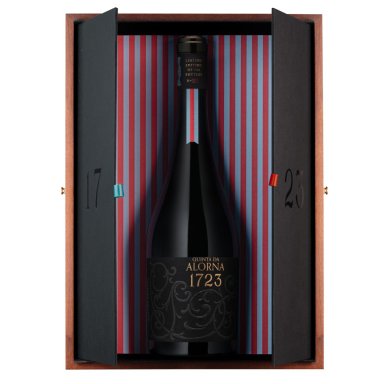Grapes : Tinta Miúda, Castelão, Alicante Boushet
The vines were planted in 1986. This festive red wine comes from the so-called "Vinha do Planalto", where the grape varieties Tinta Miúda, Castelão and Alicante Bouschet show their true essence, which is evident in a wine that stands out from beginning to end for its elegance and character. The 2019 harvest was carried out manually in 18 kg boxes, followed by selection on a sorting table for open horizontal 500 kg tanks simulating wine presses. Fermentation began with the whole bunch, as if it were a carbonic maceration. In this way, an intracellular fermentation was created that favored the fruit. The grapes were destemmed after 2/3 of fermentation, trampled until the end and then sent to a vertical press. Individually, each varietal wine was aged for 10 months in French oak barrels previously used for the Marquesa de Alorna 2016 red. The wine was bottled on November 18, 2020.
*To the south of the Tagus River lies the Charneca zone. Charneca is a dry, flat area characterized by poor sandy soils that force the vines to struggle and in turn produce more complex fruits. In this zone, higher temperatures allow the grapes to ripen faster than in the rest of the Tejo region.
Quinta da Alorna's wine-growing tradition dates back to around the date of its foundation. It was during this period that the first vineyards were planted, along with orchards, mulberry groves, forests and olive trees. Drawbridges, lakes and boxwood trees were also built, entirely in keeping with the French model that was very popular with the European elite at the time. However, it was not until the beginning of the 20th century that wine production began to be seen in a more professional way, although always as part of the universal whole that constitutes “Alorna”.
Today “Alorna” has 2,600 hectares spread over 16 kilometres, of which 1,900 hectares are forest, with centuries-old trees dating back to the time of D. João, son of the first Marquis of Alorna, 500 hectares of agricultural land producing olive oil, cereals and fruit and vegetables, and 180 hectares of vineyards. The house is also very proud of its riding school with purebred Lusitano horses. This is undoubtedly an integral part of the history of the region, of the old aristocratic houses of Ribatejo, with agricultural holdings linked to the land, the people, the horses and the tradition.
The celebration of Quinta da Alorna’s 300th anniversary took place in the palace gardens and brought together over 150 guests, including prominent figures from the sector who gathered to toast the legacy, impact and history of Quinta da Alorna. Most of Quinta da Alorna’s vineyards are located in a heathland area, on the left (south) bank of the Tagus, in plains and plateaus, where the soils of rolled pebbles and sand are clearly visible. These are not at all homogeneous and change into poor sand after just a few metres. It is precisely in these areas that the oldest vineyards can be found. However, Martta Reis Simões, winemaker at Quinta da Alorna since 2003 and director of viticulture since 2010, also recently decided to invest in the transitional soils next to the palace.
In the vineyards of Alorna grow 19 Portuguese and international grape varieties, of which the most characteristic and representative are: Castelão, Touriga Nacional, Cabernet Sauvignon, Alicante Bouschet, Fernão Pires, Arinto, Chardonnay and Sauvignon Blanc. The annual production of Quinta da Alorna amounts to two million bottles, 50% of which are exported to 23 countries.
The wines of Quinta da Alorna are very consistent and representative of the character of the region, as we could prove during the cocktail party before the presentation of the long-awaited “1723”. The Reserva Alorna Alvarinho/Viognier 2021 and Alorna Arinto/Chardonnay 2022 were served with fried fish tacos, brie almonds and creamy pear, alheira brigadeiros with spinach and sesame seeds, mini cones with Serra cheese, honey and fig, and other delicacies, and the Reserva Alorna Touriga Nacional/Cabernet Sauvignon 2019, in magnums, with oxtail with truffle mayonnaise, pickled partridge tiborna, apple and watercress and lamb skewers with tandoori sauce.
Store & Serve
Serve at 16-17°C. To drink from now until 2040
Alcoholcontent
14%vol


